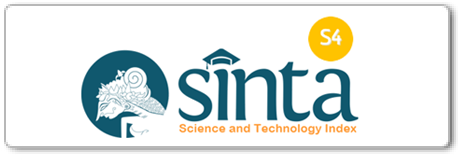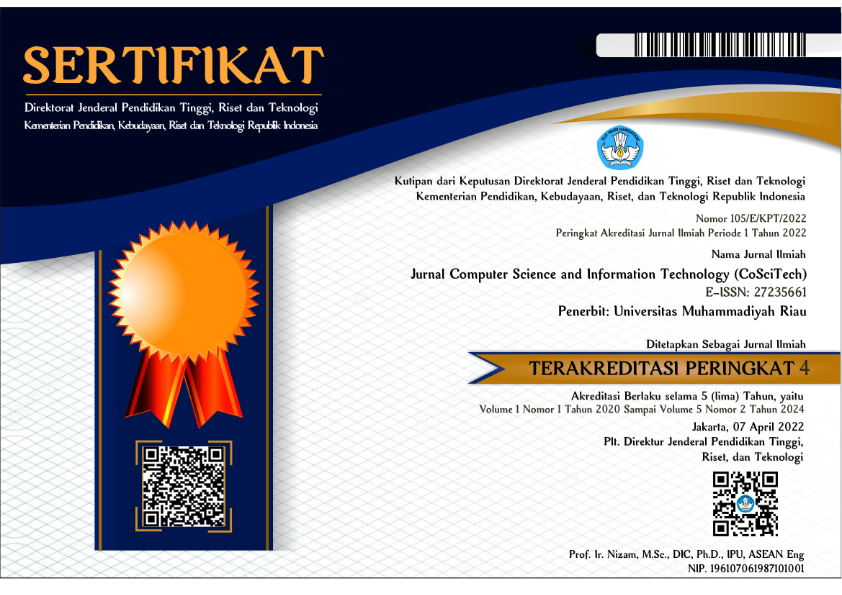Geographical information sistem for mapping mosques in the village of Dayo Rokan Hulu District
Abstract
Geographic Information Sistem (GIS) is a component consisting of hardware, software, human resources and data that work together effectively to enter, store, repair, update, manage, manipulate, integrate, analyze and display data in an information-based geographic [1]. This research was conducted to analyze the distribution of mosques and information about mosques in Dayo Village, Rokan Hulu District, Riau. The aim is to help the community, especially newcomers, to find maps of the distribution of mosques, routes to mosques, schedules for Friday prayer officers and other information that currently does not use a computerized sistem, which is an obstacle especially for the people in the Dayo Village area. The method used in data collection was by direct observation of mosques in Dayo Village and conducting interviews with mosque administrators and local residents, besides that a literature study was also carried out to find references to previous research. By using GIS, it is hoped that it will be easier for the community to find out the distribution of mosques in Dayo Village, the locations of the mosques along with the information available. All of this information can be easily accessed online via smartphones or other devices
Downloads
References
Rosdiana, F. Agus, and A. H. Kridalaksana, “SISTEM INFORMASI GEOGRAFI BATAS WILAYAH KAMPUS UNIVERSITAS MULAWARMAN MENGGUNAKAN GOOGLE MAPS API,” J. Inform. Mulawarman, vol. 10, no. 1, pp. 38–46, 2015.
K. Putrawan, Pengetahuan Dasar Peta. Jakarta: Direktorat Pembinaan SMA - Kementerian Pendidikan dan Kebudayaan, 2019.
W. K. Zaman, “Masjid sebagai pusat dakwah islam di Kampung (Studi Masjid Darus Sa’adah Desa Dahipolo Kec. Jekulo Kab. Kudus),” At-Tabsyir, J. Komun. Penyiaran Islam, vol. 6, no. 2, pp. 367–381, 2019.
G. Tendra, J. R. K. Putra, and R. Johan, “Implementasi Algoritma K-Means Clustering Pada Aplikasi Mobile Banking Bank Sampah Keluarahan Tuah Madani Kota Pekanbaru,” J. Komput. dan Inform., vol. 9, no. 2, pp. 235–243, 2021, doi: 10.35508/jicon.v9i2.5142.
Ismael, “Sistem Informasi Pengolahan Data Pembudidayaan Ikan Hias Dan Pemasaran Ikan Hias Pada Dinas Perikanan Kabupaten Tebo,” J. J – CLICK J. Sist. Inf. Dan Manaj. Inform., vol. 5, no. 2, pp. 276–285, 2018.
A. Aminuddin, “Implementasi Unified Modeling Language (Uml) Pada Perancangan Aplikasi Wifitalkie Berbasis Tcp/Ip,” Sist. J. Sist. Inf., vol. 8, no. 2, pp. 265–275, 2019, doi: 10.32520/stmsi.v8i2.484.
H. Tohari, Astah : Analisis serta perancangan sistem informasi melalui pendekatan UML, Ed.1 cet. Yogyakarta: Andi Offset, 2014.
R. A.S and M. Shalahuddin, Rekayasa Perangkat Lunak : Terstruktur Dan Berorientasi Objek. Bandung: Informatika Bandung, 2015.
A. Firman, H. F. Wowor, and X. Najoan, “Sistem Informasi Perpustakaan Online Berbasis Web,” E-journal Tek. Elektro dan Komput., vol. 5, no. 2, pp. 29–36, 2016, doi: 10.29300/syr.v18i1.1568.
O. S. Parulian, “3 Days With Mysql For Your Application: Mysql Untuk Pemula - Onesinus Saut Parulian - Google Buku,” 2017. https://books.google.co.id/books?id=MbdTDwAAQBAJ&printsec=frontcover&hl=id&source=gbs_ge_summary_r&cad=0#v=onepage&q&f=false (accessed Oct. 24, 2022).
 Abstract views: 85 ,
Abstract views: 85 ,  PDF downloads: 131
PDF downloads: 131















